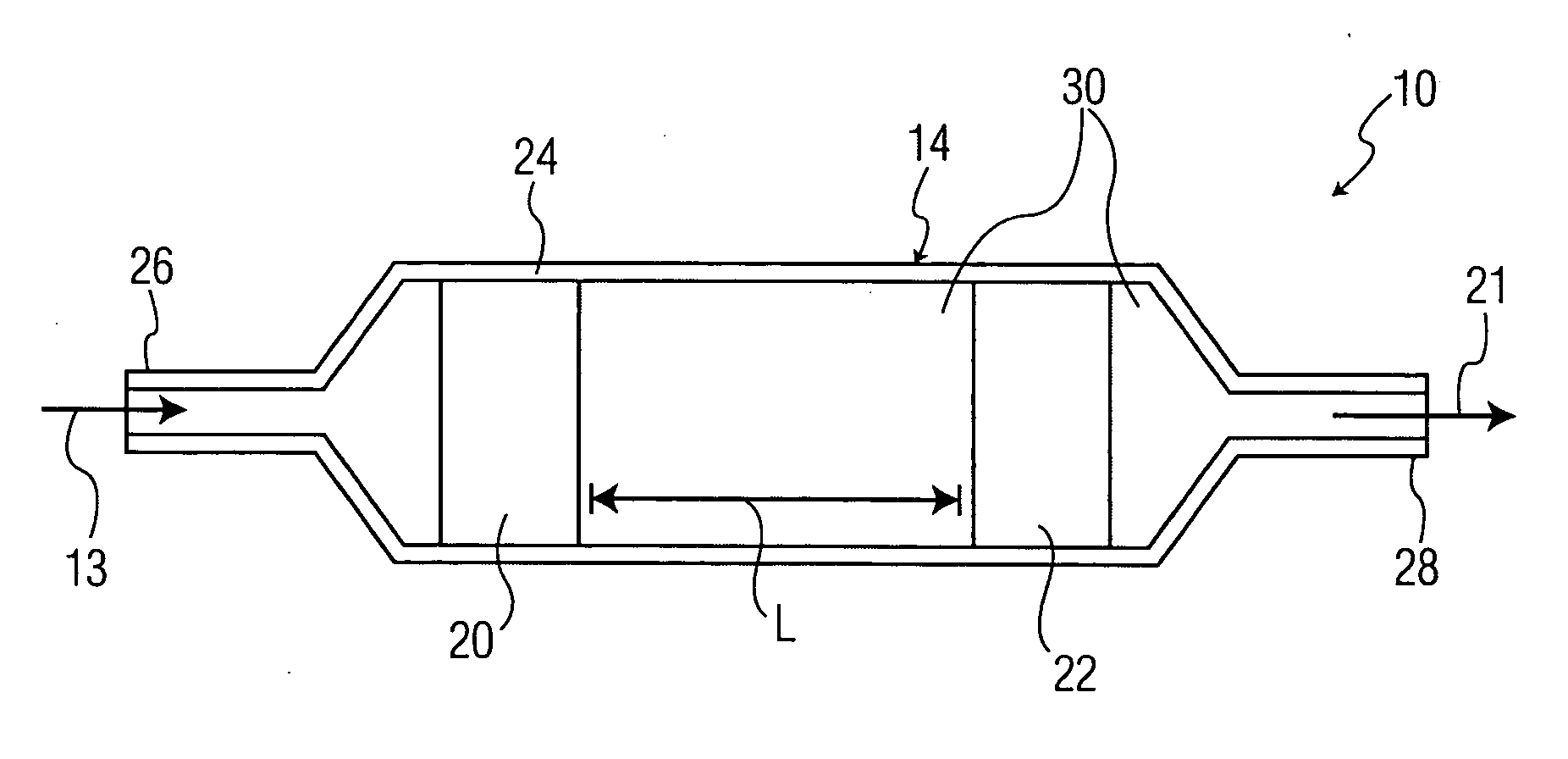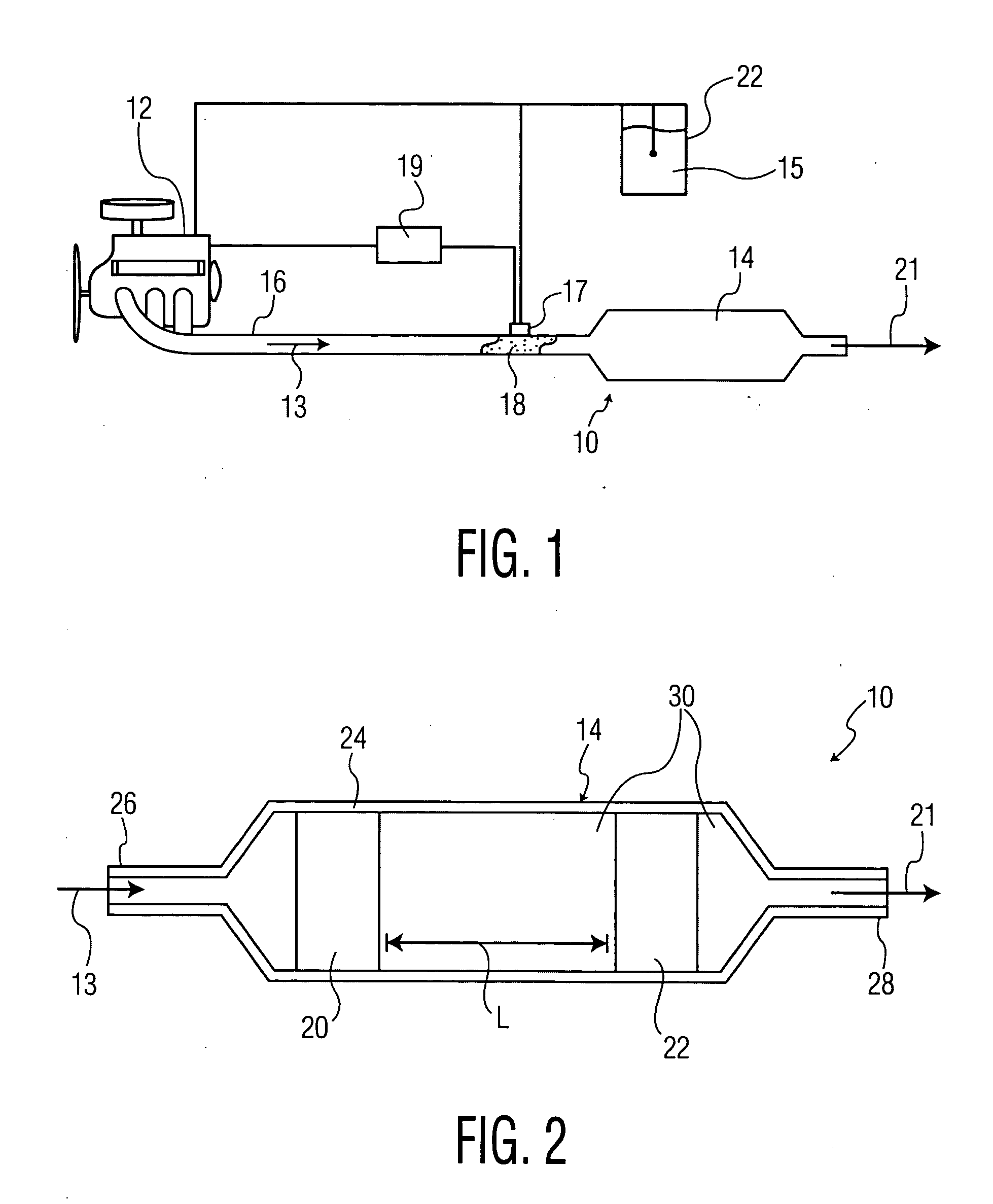Method and apparatus for combination catalyst for reduction of NOx in combustion products
a technology of combustion products and catalysts, applied in the field of catalysts, can solve the problems of inability to run stoichiometrically, emission of undesirable amounts of no/sub>x in the exhaust gases of internal combustion engines, and limited use of systems, so as to reduce nox compounds, reduce or eliminate nox compounds in exhaust gases, and widen the temperature range of operation
- Summary
- Abstract
- Description
- Claims
- Application Information
AI Technical Summary
Benefits of technology
Problems solved by technology
Method used
Image
Examples
example 1
[0049] A sample of copper containing ZSM-5 zeolite catalyst was produced by preparing a solution containing 68 grams of copper (II) nitrate hydrate and 1000 ml of deionized water. Thereafter, 200 grams of ZSM-5 zeolite crystal were added while the solution was stirred. The resulting mixture was stirred for about 1.5 hours and then the pH was adjusted to 7.25 by the addition of 35.7 grams of NH4OH. The stirring of the mixture continued for about 1 hour. The zeolite mixture was filtered, and washed with 1000 ml of deionized water. The filtrate was dried overnight at about 85° C. The exchanged zeolite was then air calcined by ramping the temperature at a rate of 2° C. / min to 550° C., holding for about 2 hours, and then cooled to room temperature. Copper analysis indicated the copper loading was about 11.5 wt. %.
[0050] A sample with 3 weight % copper loading was prepared using the above procedure by varying the amount of copper (II) nitrate hydrate.
example 2
[0051]γ-Alumina support was prepared by utilizing a complexing agent-assisted sol gel method. 500 grams of aluminum isopropoxide (AIP) (98%+, Aldrich Chemical Company, Inc.) was dissolved in 600 ml of 2-methyl-2,4-pentanediol (MPD) (99% Aldrich Chemical Company, Inc) in a beaker. The resulting mixture was stirred vigorously with a mechanical polyethylene stirrer. Once the mixture was mixed homogenously, the beaker was placed in a constant temperature bath at a temperature of about 120° C. and stirred continuously for about an hour. Once all the AIP was dissolved, a clear yellowish green solution was obtained. The AIP reacts with MPD to yield 2-propanol in the form of a vapor at the 120° C. reaction condition and the solution begins to gel. Once the gelation is completed after 4 hours, 400 ml of water was added to terminate the gelation and yield a white precipitate (aluminum hydroxide). The white solid product was redispersed in water and aged at 90° C. overnight under constant stir...
example 3
[0055] Several samples of silver containing γ-alumina catalysts were prepared via the incipient wetness impregnation technique. Aqueous silver nitrate or silver sulfate solution was added drop-wise and mixed with the γ-alumina product of Example 2. The volume of the nitrate solution was calculated to substantially match the pore volume of the γ-alumina product, which was about 1.4 ml per gram of γ-alumina. Thus, 0.322 grams of silver nitrate was dissolved in 14 ml of water and mixed with 10.0 grams of alumina. The impregnated sample was then manually mixed with a spatula, dried overnight at 90-110° C., and calcined for about 5 hours at 600° C. in the presence of air. In another preparation, 0.2966 grams of silver sulfate was dissolved in 42 ml of water because of lower solubility, and this was added in three steps using 14 ml each time with drying and calcination between the steps. The silver loading in the catalyst was 2 weight % based on the total weight of the catalyst.
PUM
| Property | Measurement | Unit |
|---|---|---|
| temperature | aaaaa | aaaaa |
| temperature | aaaaa | aaaaa |
| temperature | aaaaa | aaaaa |
Abstract
Description
Claims
Application Information
 Login to View More
Login to View More - R&D
- Intellectual Property
- Life Sciences
- Materials
- Tech Scout
- Unparalleled Data Quality
- Higher Quality Content
- 60% Fewer Hallucinations
Browse by: Latest US Patents, China's latest patents, Technical Efficacy Thesaurus, Application Domain, Technology Topic, Popular Technical Reports.
© 2025 PatSnap. All rights reserved.Legal|Privacy policy|Modern Slavery Act Transparency Statement|Sitemap|About US| Contact US: help@patsnap.com



